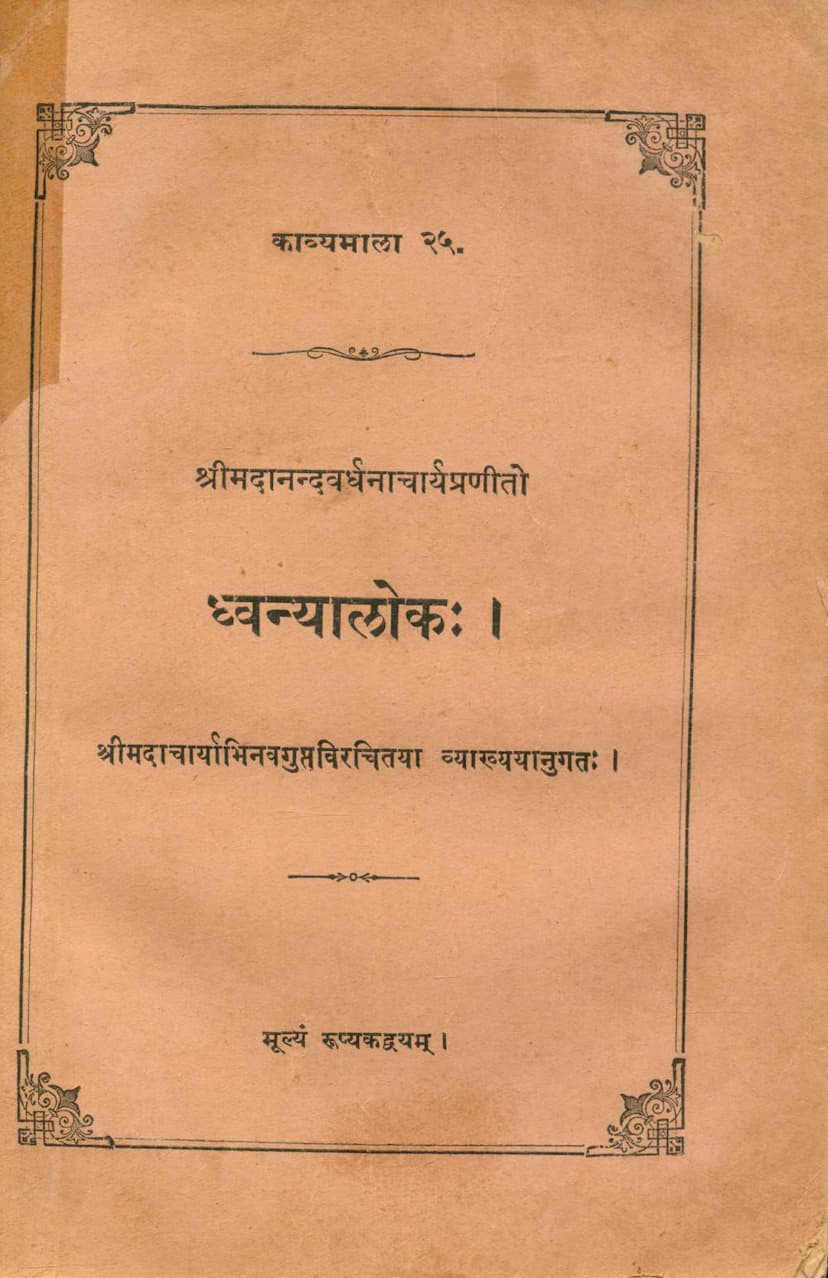Dhvanyaloak
Added to library: September 1, 2025

Summary
Here's a comprehensive summary of the provided Jain text, focusing on the content and significance of the Dhvanyaloka:
The provided text is an introduction to the Dhvanyaloka of Anandavardhana, along with its commentary, the Locana by Abhinavagupta. It appears to be a preface or introductory material to a published edition of this significant work of Sanskrit poetics.
Key Information from the Text:
- Title: Dhvanyaloka
- Author: Anandavardhana (प्रणीतो - composed by)
- Commentary: Locana by Abhinavagupta (विरचितया व्याख्ययानुगतः - accompanied by the commentary composed by)
- Editors: Pandit Durgaprasada and Wasudev Laxman Shastri Pansikar
- Publisher: Pandurang Jawaji, Proprietor of the 'Nirnaya Sagar' Press, Bombay.
- Edition: Third Revised Edition
- Year of Publication: 1928 (शाकः १८५०, खिस्तान्दः १९२८)
- Price: 2 Rupees
Content Summary and Significance:
The preface delves into the following aspects:
-
The Nature of Dhvanyaloka:
- It is stated that the Dhvanyaloka is divided into two parts: the Karika (verses) and the Vritti (commentary/explanation). The term "Dhvani" refers to the verses, and "Aloka" refers to the commentary.
- There's a discussion about whether Anandavardhana was the sole author of both the Karika and the Vritti. While some believe Anandavardhana authored both, quotes from the Locana (commentary by Abhinavagupta) suggest that the Vritti (commentary on the Karika) was by a different author, with Anandavardhana being the author of the original Karika.
-
Authorship and Identity:
- Anandavardhana: The preface establishes Anandavardhana as the author of the Karika. He is identified as a prominent figure in Kashmir during the latter half of the 9th century AD, during the reign of King Avantivarma. His father's name was 'Noṇa'. The text lists several works attributed to him, including Dhvanyaloka, Devi-shataka, Vishama-bana-lila (in Prakrit), Arjuna-charita, and a commentary on Dharmottama's Vinishchaya-tika. Of these, only Dhvanyaloka and Devi-shataka are known to have survived.
- Abhinavagupta: The commentator, Abhinavagupta (also known as Abhinavaguptacharya), is identified as a great Shiva devotee who lived in Kashmir in the latter part of the 10th century and the beginning of the 11th century AD. His work, the Locana commentary, is famous. The text mentions his teachers (Lakshmanagupta, Bhatta-Induraja, Bhatta-Tauta), grandfather (Varahagupta), father (Chukhala), younger brother (Manorathagupta), and disciples (Karna-ksema, etc.). A substantial list of Abhinavagupta's works is provided, primarily focusing on Tantric and philosophical texts, but importantly including the Dhvanyaloka-locana and the Bharatiya Natyashastra-tika.
-
The Core Concept of Dhvani:
- The Dhvanyaloka is dedicated to establishing Dhvani as the soul of poetry (kavyasya atma dhvani). This concept posits that the highest form of poetry conveys a meaning beyond the literal words, a suggested or implied sense that delights the hearts of refined readers (sahridaya). This implied meaning is called Vyanjana or Dhvani.
- The preface highlights the debate surrounding Dhvani:
- Some argued that Dhvani is not distinct from the literal meaning (Vachya) or other poetic elements like figures of speech (Alankara) and qualities (Guna).
- Others argued that Dhvani doesn't exist at all.
- A third group suggested that Dhvani might be a form of transferred meaning (Bhākta).
- Finally, the commentators and proponents of Dhvani (like Anandavardhana and Abhinavagupta) proposed that Dhvani is a distinct and essential element of poetry, the very soul, which is perceived intuitively by the sahridaya.
-
References and Citations:
- The preface meticulously lists authors and works that Anandavardhana cited in the Dhvanyaloka to support his theories and illustrate various concepts. This list includes prominent figures like Amaruka, Kalidasa, Bana, Bharata, Bhamaha, Dandin, and Vamana, along with their works.
- Similarly, it lists authors and works that Abhinavagupta referred to in his Locana commentary, providing valuable context about the intellectual lineage and influences.
-
The Editors' Effort:
- The editors, Pandit Durgaprasada and Wasudev Laxman Shastri, mention that they compiled the text based on three different manuscripts (designated as क, ख, and ग). They acknowledge the inherent difficulty of the text and the potential for errors due to the complexity of the subject matter and the manuscripts themselves, seeking indulgence from readers.
Overall Significance:
The Dhvanyaloka is a foundational text in Indian aesthetics and literary criticism. Anandavardhana's theory of Dhvani revolutionized the understanding of poetry, moving beyond mere ornamentation and formal beauty to emphasize the suggestive power of language and the role of the reader's aesthetic sensibility. Abhinavagupta's Locana commentary is considered a classic, clarifying and defending Anandavardhana's complex theories. This particular edition, with its meticulous editing and comprehensive introduction, serves as a crucial resource for understanding this seminal work and its place in Indian literary tradition. The preface itself is valuable for historical context, authorship discussions, and understanding the intellectual landscape of Sanskrit poetics.